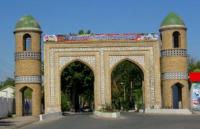You are here
History of Kurgan-Tobe.

Tours over Southern Tajikistan.
According to some sources, Qurghonteppa emerged in the VIIth century, although others think much later. The city is situated in the upper part of the Vakhsh valley in the centre of a rich oasis. In the Middle Ages the area was known as Khuttal and the city itself as Levaqand or Vakhsh.
This area was famous at that time for its marksmen and its special breed of sheep. Al-Istakhri describes Khuttal in detail in his work “The book of the Ways of States”. Munk (an area of present-day Khovaling), which was bigger than Hulbuk, the capital of Khuttal, was considered the largest town in Khuttal. Khelaverd and Levaqand were also large towns.
Levaqand (Vakhsh) is also mentioned in the book Qanun al-Mas’udi (by the famous scholar Al-Biruni), which gives an extensive list of places with indications of their coordinates. Information about the history of the town and region can be obtained in the Oblast Museum of History and Regional Studies which was opened in Qurghonteppa in 1983.
Unique materials on the ethnography and culture of this area are displayed in the museum. Near Qurghonteppa, on the banks of the Vakhsh River, there is an interesting historical site – the ruins of the ancient town of Lagman (X - XIIth centuries).
Kurgan-Tyube is an important industrial and cultural center of the Vakhsh Valley the administrative center of Khatlon Oblast (province) lays 99 km south of Dushanbe. According to one data Kurgan-Tyube has arisen in VII century, according to the other much later.
Today, it is a provincial town with little to see or do. Useful information about history of the town and region can be found in the Regional Historical Museum, which was opened in 1983. Close to Kurgan-Tyube, at the bank of the Vakhsh River, there is an interesting historical place - ruins of the ancient city Lagman (X - XIII centuries).
In the XX century archeologists surveyed the ancient city and have found here pipes of the ancient water-supply system, well laid out by bricks, and fortress walls with towers. 12 km to east of Kurgan-Tyube there is an Ajina-Tepa hill ("A Witch’s Hill”).
1,300 years ago there was a Buddha monastery consisting of a temple and monastery’s parts, two rectangular court yard, buildings and strong walls in 2,4 meters of thickness. In the 60th of the last century archeologists have dug out here huge figure of lying Buddha (about 12 meters length), which today can be seen in the National museum.
In the 1940s archaeologists examined it and found pipes from an ancient water supply system, brick wells, and six-meter fortress walls with towers. This town was one of the ancient Bactrian settlements and occupied quite a large area for that era – 43 hectares.
Bazaar in Kurgan-Tyube amazes by riches of choice both abundance of vegetables and fruits.
Authorship:
The Tourist guidebook on monuments of Tajikistan. 2012.







